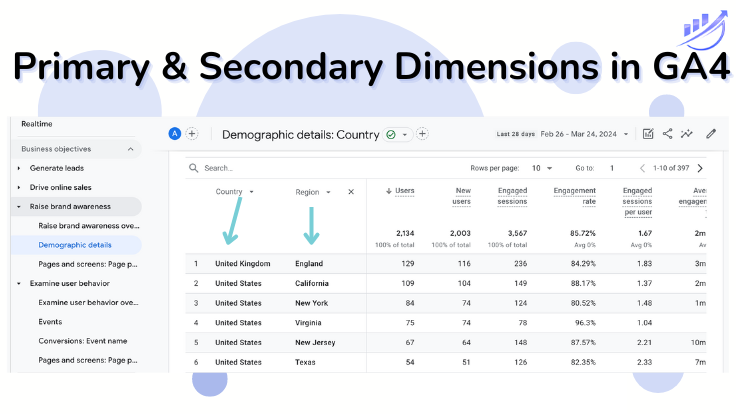Navigating the Depths of Second Measurement in Google Analytics: A Thorough Expedition on Its Performance
Second measurements, though apparently straightforward at initial glimpse, nurture a riches of untapped prospective waiting to be used. As we begin on this trip to check out the nuanced capability of secondary dimensions, we will uncover exactly how this attribute can brighten patterns, unveil connections, and inevitably lead the way for educated decision-making in the electronic landscape (what is a “secondary dimension” in google analytics?).
Understanding Additional Dimensions in Google Analytics

Recognizing how secondary dimensions job is crucial for leveraging the complete power of Google Analytics. These measurements assist you address more complex questions regarding user behavior and the efficiency of your site content and advertising initiatives. As an example, you can use second dimensions to evaluate which tools or web browsers are most frequently used by site visitors that purchase, or to compare the bounce rates of various website traffic resources. By integrating primary metrics with secondary measurements, you can acquire beneficial insights that drive notified decision-making and optimization strategies - what is a “secondary dimension” in google analytics?.
Leveraging Secondary Measurements for Data Analysis
Building upon the fundamental understanding of just how secondary measurements enhance data analysis in Google Analytics, the usage of these extra layers of info ends up being paramount in removing valuable understandings for informed decision-making and optimization strategies. By leveraging additional measurements, analysts can dive much deeper right into the efficiency metrics by adding even more context to the primary dimensions, thus uncovering surprise patterns and correlations that might not be apparent initially glance. This deeper degree of evaluation makes it possible for organizations to better understand user habits, recognize patterns, and determine areas for renovation.
Moreover, second dimensions offer a more comprehensive sight of the information, permitting segmentation based on different criteria such as demographics, tools, traffic resources, and more. This segmentation promotes a much more granular analysis, making it possible for companies to tailor their campaigns and methods to certain target market sectors for improved targeting and customization. In significance, the tactical use of secondary measurements encourages companies to make data-driven choices that drive development and success in the electronic landscape.
Advanced Techniques for Additional Measurement Execution
Discovering intricate approaches to harness the complete possibility of additional measurements in Google Analytics elevates the deepness and sophistication of information analysis for critical decision-making. One sophisticated strategy for implementing secondary dimensions is the usage of custom-made dimensions. In addition, combining second dimensions with sophisticated sectors can offer even extra granular understandings by applying multiple layers of segmentation to the data.
Interpreting Insights With Second Dimensions

When translating insights with secondary measurements, it is vital to think about the context of the data and exactly how different measurements interact with each other. As an example, understanding which particular web traffic resources cause greater conversion prices or recognizing which devices users favor for making purchases can provide workable insights for enhancing marketing campaigns and improving overall site efficiency. By very carefully taking a look at the data with additional measurements in mind, companies can make enlightened decisions that drive purposeful results and enhance their electronic visibility.
Maximizing Efficiency With Second Dimensions

One key way to maximize efficiency with second measurements is by segmenting data more granularly. This enables you to isolate details elements that may be influencing your metrics and gain a much better understanding of what drives success or failing in your digital efforts. By integrating secondary measurements such as 'tool group' and 'landing web page,' you can identify which device types are most reliable for particular touchdown web pages, allowing you to customize your approaches accordingly.
Furthermore, making use of second dimensions can assist you identify fads, patterns, and correlations that may not be evident when analyzing information with primary measurements alone. This much deeper level of analysis can cause more informed decision-making and inevitably improve the total performance of your web site or electronic advertising projects.
Verdict
Finally, secondary measurements in Google Analytics play an important role in boosting why not try here information analysis and providing much deeper understandings right into site performance. By using sophisticated strategies and translating the information properly, businesses can optimize their methods and boost general efficiency. Comprehending the performance of second measurements is crucial for making informed decisions and driving success in the electronic landscape.
By leveraging additional measurements, experts can dive much deeper into the efficiency metrics by adding more context to the main measurements, hence discovering concealed patterns and relationships that may not be evident at first look. One sophisticated technique for executing second dimensions is the use of custom measurements.Having mastered innovative techniques like custom measurements and regex for additional dimension implementation in Google Analytics, the following critical step is interpreting the beneficial insights acquired through these advanced data division methods. Interpreting understandings with additional dimensions involves analyzing the connections between the primary and additional measurements selected, discovering patterns, fads, and relationships that may not be immediately check this obvious when looking at the information in its whole.When analyzing understandings with additional measurements, it is vital to consider the context of the data and how different measurements interact with each other.